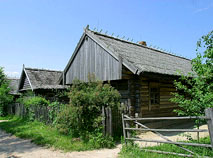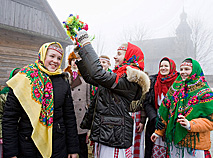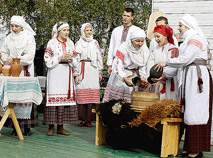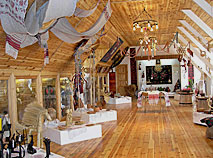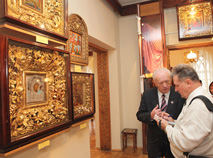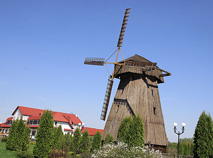Ethnographic museums in Belarus
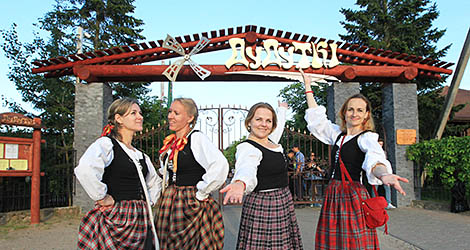
If you like to take a glimpse into the history of Belarus, feel the uniqueness of its culture and see how Belarusians lived in the ancient times, an ethnographic museum or an open-air complex is your number one choice.
Here you can learn about the traditions and life of the Belarusian people, participate in folk games, listen to folk songs and learn Belarusian national dances, watch craftsmen working and make real Belarusian souvenirs, taste the national cuisine.
Belarusian State Museum of Vernacular Architecture and Ethnic Heritage (the village of Ozertso)
 It is Belarus’ single museum-skansen that represents a whole village of architectural specimens of the 17th-20th centuries.
It is Belarus’ single museum-skansen that represents a whole village of architectural specimens of the 17th-20th centuries.
The museum is located several kilometers away from Minsk – between the villages of Ozertso and Strochitsa. It is often named "Museum in Ozertso", "Museum Strochitsa", "Strochitsy"…
The idea to develop an open-air complex was first voiced by well-known Belarusian artist Ferdynand Ruszczyc in 1908. However, World War I and World War II, the need to rebuild the postwar country postponed the opening of the museum for many decades.
A large-scale scientific expedition involving architects, historians and ethnographers was undertaken in 1976. The expedition toured various regions of Belarus, searching, examining and transporting specimens of wooden architecture, household goods and crafts to the site of the present-day museum.
A number of expositions featuring architecture, culture and everyday life of three ethnographic regions – Central Belarus, Poozerye and Dnieper Region. – were opened in the period from 1987 to 1994. Today the museum displays nearly 40 objects. Among them are:
-
Pokrovskaya Church of the 18th century
-
Parochial school
-
Wind mill and a barn
-
Tavern
-
Blacksmith’s shop
-
Bathhouse
-
Houses of well-off and poor peasants
 Expositions of the museum include "Transportation Means of Belarus", "Beekeeping in Belarus", "Belarusian flax", "Zabrody Fishing Gear" (fishery in Belarus).
Expositions of the museum include "Transportation Means of Belarus", "Beekeeping in Belarus", "Belarusian flax", "Zabrody Fishing Gear" (fishery in Belarus).
The Belarusian State Museum of Vernacular Architecture and Ethnic Heritage holds numerous national feasts and rites, festivals and concerts:
-
Kolyada
-
Pancake Week
-
Spring Calling
-
Kupalle
-
Autumn Fest
-
Project "Masterpieces of the World Classics in the Open-Air Museum"
-
Day of Museums
Visitors to the museum have a chance to take part in various festivities, enjoy true potato pancakes, vereshchaka, sbiten, other dishes and drinks of the Belarusian cuisine in a local tavern.
Location:
Minsk District, between the village of Ozertso and the village of Strochitsa, on the bank of the Ptich River
Museum of Old Folk Crafts and Technologies Dudutki
 Dudutki is one of the most attended museums in Belarus. It is located 40km away from Minsk in a picturesque site near the Ptich River.
Dudutki is one of the most attended museums in Belarus. It is located 40km away from Minsk in a picturesque site near the Ptich River.
Close to the village of Dudichi, next to the complex there once stood the mansion of the Yelsky family that turned Dudichi into a big crafts and trading center, a “manor of muses”.
By 1800 the mansion included not only the house of the hosts and crafts shops but also a wooden church, a wind mill, three taverns, a garden, a greenhouse, a small tannery. Fairs were held every  month there.
month there.
The Dudutki museum, which opened in 1994, was initiated by Belarusian journalist Yevgeny Budinas. The complex, which recreates the life of the Belarusian country estate of the 19th century, is based on the rich history of Dudichi.
Today Dudutki offers:
-
Ethnographic gallery featuring the items of the 18th-20th centuries
-
Handicraft yard (straw and willow weaving)
-
Pottery (museum of ceramics)
-
Woodworker’s shop
-
Blacksmiths shop of the 19th century
-
Creamery
-
Bakery
-
Brewery (a vodka brewing shop)
-
Shed with vintage cars (Zim, Chaika, Horch, Willis, Volkswagen Beetle, Ganomak, Fiat Topolino, Chrysler)
-
Wind mill in the Dutch style (built in the 1903-1905 by brothers Mikhail and Ivan Polyakovs)
-
Wooden church of John the Prophet
-
Stable with pedigree horses, a pony and a donkey
-
Zoological gardens (with cows, goats, pigs, rabbits, poultry)
-
Ostrich farm
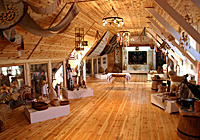 Visitors to the museum are offered to taste products from a local brewery (home-distilled vodka, bread, honey and cucumbers), from a bakery (freshly baked bread, butter and three kinds of cheese) and from a local mill (bread baked by peasants with a piece of lard).
Visitors to the museum are offered to taste products from a local brewery (home-distilled vodka, bread, honey and cucumbers), from a bakery (freshly baked bread, butter and three kinds of cheese) and from a local mill (bread baked by peasants with a piece of lard).
The museum has a café (Dududki, Korchma), the Shinok bar, the Ptich hotel and a guest house with a sauna.
During the entire year the Dududki complex holds feasts and festivals:
-
Pancake Week
-
Opening and closing of a season (the Yelsky family heritage)
-
Victory Day and Independence Day
-
Festival of street artists
-
Blacksmiths’ plein air
-
Kupalle open-air festival
-
Patronal feast of the Dududki church
-
Our Grunwald festival to commemorate the contribution of the Belarusian armies to the victory in the Battle of Grunwald in 1410
-
Ethno Mlyn feast
-
Feast of Three Spas (Honey Spas, Apple Spas and Spas on Canvas, held in late August)
-
Christmas exhibition
Address:
1.5 km from the Dudichi village, Pukhovichi District, Minsk Oblast
History and Culture Museum-Reserve Zaslavl
 Zaslavl is one of the most ancient Belarusian towns. It was first mentioned in chronicles in 1127. However, it was founded much earlier.
Zaslavl is one of the most ancient Belarusian towns. It was first mentioned in chronicles in 1127. However, it was founded much earlier.
Some marvelous historical monuments have survived in Zaslavl. All of them were brought together in 1986 to make part of the History and Culture Museum-Reserve Zaslavl.
Currently this museum includes the monuments of both international and national importance:
-
Zamechek ancient settlement of the 10th-11th centuries (known in chronicles under the name Izyaslavl)
-
Burial mounds of the 10th-11th centuries
-
Val ancient settlement with the Calvinist protestant church (11th-17th centuries, Zaslavl Castle)
-
Roman Catholic Church of Holy Mary’s Nativity (second half of the 18th century)
-
Park and the palace of the Przezdziecki family.
Other sights worth visiting are:
-
Museum and exhibition complex
-
Mlyn (the Mill) ethnographic complex
-
Pillbox-turned-museum
-
Children’s mythology and forest museum
 A key part of the Mlyn ethnographic complex is a steam mill, which is a unique monument of the 20th-century flour manufacture in Zaslavl. Here one can see a granary, a smithy and an authentic inn for peasants who delivered grain to the mill.
A key part of the Mlyn ethnographic complex is a steam mill, which is a unique monument of the 20th-century flour manufacture in Zaslavl. Here one can see a granary, a smithy and an authentic inn for peasants who delivered grain to the mill.
The Zaslavl museum offers excursions combined with theatrical performances and Batleika performances (puppet plays focusing on the Biblical stories).
Address:
4 Rynochnaya Street, Zaslavl
Vetka Museum of Old Belief and Belarusian Traditions
 The town of Vetka and its outskirts are an extremely interesting place in south-eastern Belarus. It was the place where Belarusian Old Believers settled after the schism in the Orthodox Church in the late 17th and 18th centuries.
The town of Vetka and its outskirts are an extremely interesting place in south-eastern Belarus. It was the place where Belarusian Old Believers settled after the schism in the Orthodox Church in the late 17th and 18th centuries.
The Vetka Folk Arts Museum was established in 1978 and was based on the personal collection of Fyodor Shklyarov, whose forefathers were members of the local group of Old Believers. Fyodor Shklyarov was an amateur artist who collected antiquities. In 1987 his permanent exhibition was opened in a completely renovated historic building where merchant Groshikov once lived.
 The Shklyarov Museum of Old Belief and Belarusian Traditions in Vetka currently includes over 10,000 items that represent history and culture of the villages where both Old Belief and Orthodox church traditions co-existed:
The Shklyarov Museum of Old Belief and Belarusian Traditions in Vetka currently includes over 10,000 items that represent history and culture of the villages where both Old Belief and Orthodox church traditions co-existed:
-
Ancient and Old Believers’ icons
-
Hand-written and first examples of printed books of the 16th-19th centuries
-
Collections of sketches made by icon-painters of the 17th-20th centuries
-
Collections of items made with the help of a unique artistic method (thread, beads and pearls sewing)
-
Collection of house decoration items made using the sawn carving technique (19th-20th centuries)
-
A collection of ritual towels
-
Archaeological finds
-
Traditional garments
The Belarusian Old Believers created hand-written books with magnificent miniature illustrations and ornaments. They were skilled icon-writers, too. The collection features works by Ivan Fyodorov and Piotr Mstislavets.
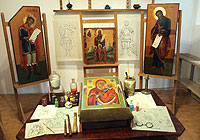 Currently excursions and thematic exhibitions are held in the Vetka museum. An electronic guide is available in four languages, too. The Living Craft section tells guests about traditions and secrets of the Belarusian weaving.
Currently excursions and thematic exhibitions are held in the Vetka museum. An electronic guide is available in four languages, too. The Living Craft section tells guests about traditions and secrets of the Belarusian weaving.
A branch of the Vetka museum is located in Gomel. It holds folk feasts (such as Belarusian dancing and music gatherings) and master classes in weaving and Easter eggs painting.
Address:
5 Krasnaya Ploshchad Street, Vetka, Gomel Oblast
Filial branch: 4 Lenina Square, Gomel (on the territory of the park and the palace of the Rumyantsev-Paskevich family).
Folk Arts Museum Bezdezhsky Fartushok
 The Belarusian village of Bezdezh, which is over 600 years old, prides itself on snow-white flax aprons, which have become a true brand of the locality.
The Belarusian village of Bezdezh, which is over 600 years old, prides itself on snow-white flax aprons, which have become a true brand of the locality.
Craftswomen toiled a lot to create an apron. Flax was collected at a precisely defined time, it took ages to convert it into the finest yarn – 300 threads had to be as thin as to go through a wedding ring. Special secrets were used to obtain the famous white color of the fabric. After that symbolic patterns were embroidered upon ready aprons.
In 1999 the museum Bezdezhsky Fartushok was opened in the village. It features an extensive collection of ancient aprons and other articles of the national costume, rushnyks.
 It offers captivating excursions that tell visitors about the everyday life of Belarusians and folk fashion traditions. They are often accompanied by music and songs by local folk music bands. You can see the rare pitchfork dance Nikita in the village of Bezdezh.
It offers captivating excursions that tell visitors about the everyday life of Belarusians and folk fashion traditions. They are often accompanied by music and songs by local folk music bands. You can see the rare pitchfork dance Nikita in the village of Bezdezh.
The estate Kalya Plesa operates as part of the museum. It is a true farmhouse where the everyday life of Polesye village residents has been recreated. Tourists can examine the estate and go fishing, ride in a road cart, taste ancient dishes (potato pancakes, bacon, Bezdezh bread, fresh milk and cheese) and appreciate the taste of an aboriginal spice made from crushed flax seeds.
On Easter the village of Bezdezh is home to a unique spring rite Strelka.
Where:
9 Pionerskaya Street, Bezdezh, Drogichin District, Brest Oblast
Tourism and recreation complex Belarusian Ethnographic Village of the 19th Century
 The complex Belarusian Ethnographic Village of the 19th Century is an open-air facility located 2km away from Mogilev opposite to the memorial complex Buinichi Field.
The complex Belarusian Ethnographic Village of the 19th Century is an open-air facility located 2km away from Mogilev opposite to the memorial complex Buinichi Field.
The village is not a full-scale museum, but can get visitors familiar with peculiarities of a 19th century Belarusian town, traditions of the nation, rites, and crafts.
There is a craftsmen street in the ethnographic village. The street consists of seven houses:
-
potter’s
-
baker’s
-
carpenter’s
-
blacksmith’s
-
weaver’s
-
house of craftsmen specializing in embroidery, straw and vine wickerwork
-
moonshiner’s
Visitors can see craftsmen at work there and buy souvenirs made by their own hands, taste strong alcohol beverages, learn about the ancient ways of baking bread and pastry and taste some of the products.
The landmarks of the village are a huge wind mill and a house in the traditional gentry style where the inn and the restaurant (a tavern) are located.
Ethnic festivals, fairs, and Belarusian folk holidays are staged in the tourism and entertainment complex Belarusian Ethnographic Village of the 19th Century.
Where:
The village of Buinichi, Mogilev District
Village Museum Zabrodye
 In the historical places on the bank of the Narochanka River that were once a frontline of the First World War, there is an old village Zabrodye. The family of Belarusian artist and regional ethnographer Boris Tsitovich has turned it into an open-air unique museum, telling the story of the military past, and an entertaining tourist complex with authentic architecture, ethnography and creative atmosphere.
In the historical places on the bank of the Narochanka River that were once a frontline of the First World War, there is an old village Zabrodye. The family of Belarusian artist and regional ethnographer Boris Tsitovich has turned it into an open-air unique museum, telling the story of the military past, and an entertaining tourist complex with authentic architecture, ethnography and creative atmosphere.
Today Zabrodye offers:
-
Belarus’ first museum of WWI history displaying over 2000 exhibits: uniform and weapons, a gas mask, documents and photos, welfare items and personal things of soldiers;
-
a museum of vintage cars with the rarities of the 1930s-1990s on show: ZIS-5, GAS-67, GAS M1, Willys, Opel Kadett, Opel Blitz…
-
an exposition of motorcycles and bicycles;
-
a 19th century period-house museum (furniture, towels, clothes, household stuff, musical instruments, photos);
-
a smithy and a bath-house, which is two centuries old;
-
art and puppet theater studios …
On the bank of the river there is a wooden Boris and Gleb Chapel, built in the style of the 16th-17th centuries. The chapel was built to commemorate all killed in the warfare. Also among the most venerated places of Zabrodye and its suburbs is a hospital cemetery of the First World War and a six-meter cross at the grave near the military camp, a chapel to honor the 80th anniversary of the end of the war, a stela and a stone at the place of the death of Cossack Daniil Shevchenko…
Zabrodye hosts annual events to celebrate the history of the region:
-
a motor rally along the places commemorating the victims of World War One,
-
Victory Day remembering the soldiers of the two world wars,
-
Remembrance Day of Heroes and Sacrifices…
Zabrodye offers tourists authentic country houses and camp sites, a summer cafe and a souvenir shop, excursions and entertainment programs.
Where:
Village of Zabrodye, Vileika District, Minsk Oblast







 print version
print version make home page
make home page add to bookmarks
add to bookmarks

